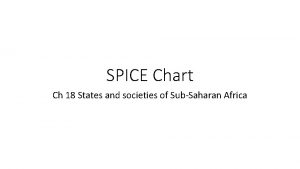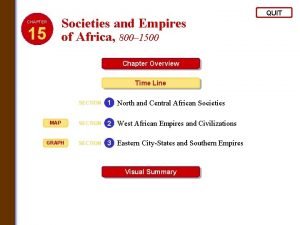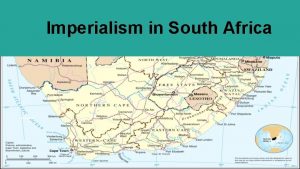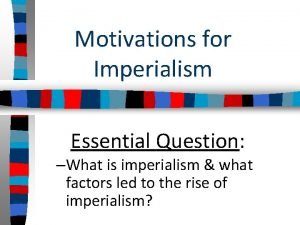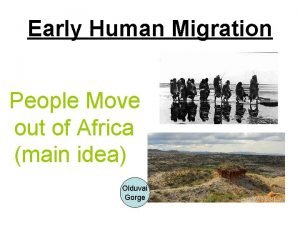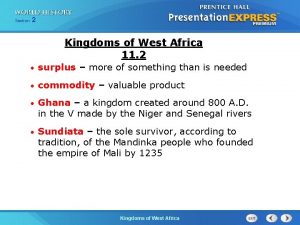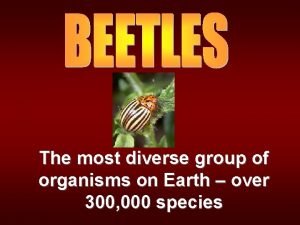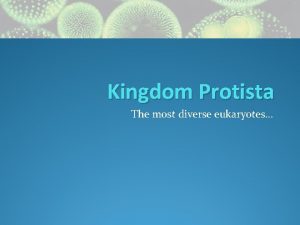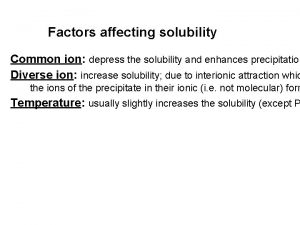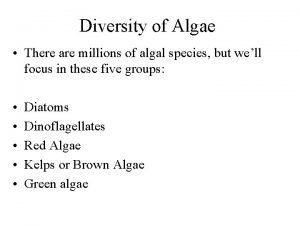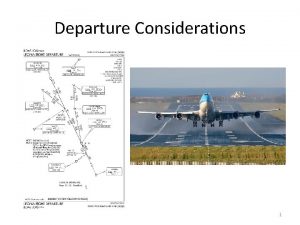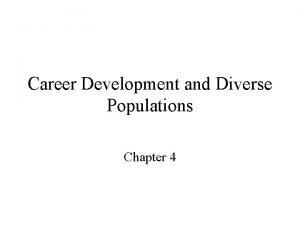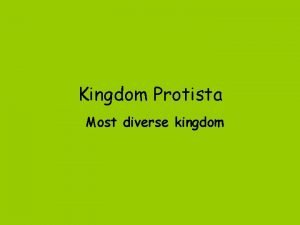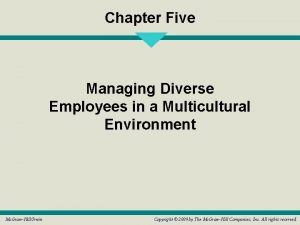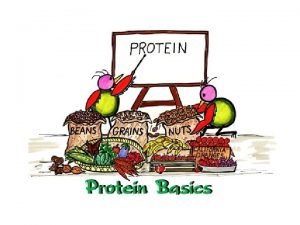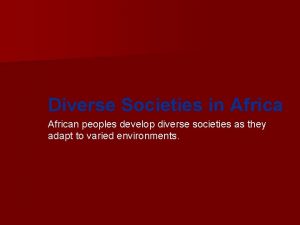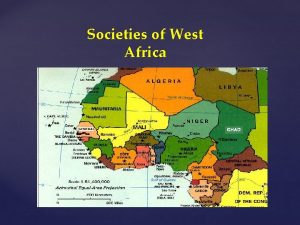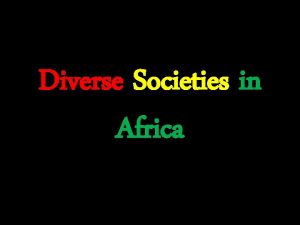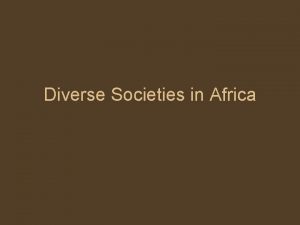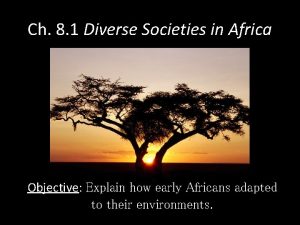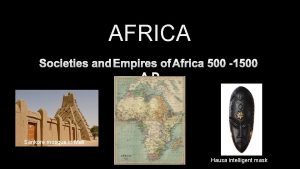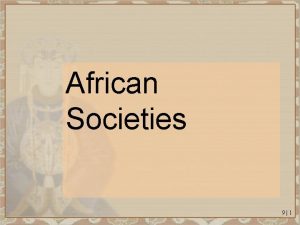Topic Diverse Societies in Africa EQ How did


































- Slides: 34

Topic: Diverse Societies in Africa EQ: How did the environment in Africa help to develop diverse societies?

Africa: A Land of Geographic Contrasts • Africa is the second largest continent in the world • 4, 600 miles east to west, 5000 miles north to south

Challenging Environments • Deserts – unsuitable for human life, make movement to better environments challenging • Largest – Sahara in the north, Kalahari in the south • The Sahara desert covers an area the size of the United States • Desert is spreading into the semiarid area known as the Sahel

Challenging Environments • Rainforest – Trees up to 150 feet tall with a canopy that prevents sunlight from reaching the ground • Tstse fly found in the rain forest makes it hard to inhabit • Parasite (bloodsucker) • Transmits diseases • Prevented farmers from using cattle, donkeys, and horses to farm near the rainforest • Silver lining – prevented invaders and European colonizers from occupying the area

Welcoming Lands • Northern coast and southern tip – Climate similar to the Mediterranean (Italy, Greece, etc. ) and fertile soil • Heavily populated with farmers and herders • Savannas – 40% of the continent, where most people live • grassy plains with mountainous highlands and swampy tropical stretches • Alternating wet/dry seasons


The First Humans • The first humans appeared in the Great Rift Valley and migrated outward


Hunter-gathering societies • First form of social organization • Still exist in Africa today – small tribes with own languages and culture

Hunter-gathering societies • The Efe • Nomadic hunter-gatherer society that still exists today • Groups of 10 -100 live together in temporary grass/brush shelters • Move frequently to follow food • Women forage, men hunt using bow/arrow • Patriarchal – led by a respected male elder • No formal laws



Pastoral societies • Pastoral = herd grazing animals • Early Africans – cattle, goats, sheep • Modern Africans – The Masai of Kenya/South Africa are still pastoralists and measure their wealth by the size of their herds • The Masai diet includes: Meat, milk, BLOOD • Traditionally lived in bands of 12 households, smaller groups today • Multiple bands work together in animal husbandry




Transition to a settled lifestyle • Agriculture developed in Africa around 6000 BC • Between 8000 -6000 BC the Sahara received increased rainfall and became a savanna, dried up again by 6000 BC • Early farmers moved east to the Nile Valley and south into West Africa • Some settled in the savanna – best land for growing grain

Transition to a settled lifestyle • South and east of the rainforest, cattle became important • Farming in the rainforest – root crops • Growing food = permanent shelters, increased lifespan and birthrate, development of skills • Metalworking, pottery making, etc.

Early Government • Permanent settlements = increased complexity = need for governance • Village chief, council of family leaders • Stronger groups conquered weaker settlements, eventually grew into great kingdoms

Stateless Societies • In many African societies, families are organized into groups called lineages • Lineage – people who are descended from a common ancestor • Includes past and future generations • Stateless societies use lineages for leadership, no formal central government • Authority balanced among lineages

Stateless Societies – the Igbo (Ibo) People of West Africa The Igbo elders come together to settle problems in the community

Stateless Societies • Patrilineal societies – trace ancestry through their fathers • Inheritance passes from father to son • Matrilineal societies – “ ” mothers • Young men inherit land wealth from mother’s family • Age-set System – Young people form ties with people outside their lineage • Go through stages of life together (warrior, elder, etc. ) • Marked by ceremonies • Used by the Igbo

Stateless Societies • Practice local, polytheistic religions • Animism – Religions that believe spirits are present in nature and regulate daily life • Also honor the spirits of ancestors • Ceremonies to ask spirits for intervention in health, fertility, wealth, protection, etc.

Stateless societies • Few societies had written language • West Africa - Used Griots to pass down history and stories through oral tradition

How did people come to West Africa? • Archeologists believe people migrated from North Africa to West Africa as a result of desertification • Soil dried up, forcing people to move to find better farmland • Led to the development of advanced societies in presentday Mali and Nigeria

West African Iron Age • Evidence suggests that West African cultures began smelting iron for tools and weapons as early as 500 BC, skipping the Copper and Bronze ages. • Pottery, charcoal, slag – a byproduct of iron smelting • Major technological achievement of the Nok people, West Africa’s earliest known culture

Nok Culture • Lived in Nigeria between 500 BC and AD 200 • Artifacts found in a 300 mile stretch from the Niger and Benue rivers • First West African people to smelt iron



Djenné-Djeno • Ancient city south of the Sahel located on a tributary of the Niger River • Oldest known city south of the Sahara – Oldest objects from c. 250 BC, lasted until c. 1400 AD • Advanced civilization – artifacts include pottery, copper hair pieces, clay toys, glass beads, stone bracelets, iron knives, etc.

Djenné-Djeno • Ancient city south of the Sahel located on a tributary of the Niger River • Oldest known city south of the Sahara – Oldest objects from c. 250 BC, lasted until c. 1400 AD • Advanced civilization – artifacts include pottery, clay toys, iron knives; glass, bronze, and stone jewelry


Djenné-Djeno • Early – lived in round reed huts plastered with mud • Later – Mud bricks • Fishing, rice, cattle • River trade - Traded rice, fish, and pottery for copper, gold, and salt • Important center of trade – from the river and overland camel routes

 African iron age
African iron age Diverse societies in africa
Diverse societies in africa Diverse diverse
Diverse diverse Africa spice chart
Africa spice chart Chapter 15 societies and empires of africa
Chapter 15 societies and empires of africa Example of a clincher
Example of a clincher Tapic about internet
Tapic about internet Imperialism in south africa timeline
Imperialism in south africa timeline Did the dutch colonize south africa
Did the dutch colonize south africa When did the dutch colonize south africa
When did the dutch colonize south africa How did europe imperialize africa
How did europe imperialize africa Early human migration map
Early human migration map How did the kingdoms of west africa develop and prosper
How did the kingdoms of west africa develop and prosper Most diverse group of organisms
Most diverse group of organisms Ce este refractia luminii
Ce este refractia luminii The most diverse eukaryotic kingdom is
The most diverse eukaryotic kingdom is What is online platforms sites and content
What is online platforms sites and content Indirizzo politico
Indirizzo politico Diverse ion effect
Diverse ion effect Diversity of algae
Diversity of algae Omnidirectional departure
Omnidirectional departure Career development of diverse populations
Career development of diverse populations Art is diverse
Art is diverse Altezza del parallelogramma
Altezza del parallelogramma We live in a diverse world
We live in a diverse world Chapter 16 ap human geography
Chapter 16 ap human geography Circus possessive form
Circus possessive form It is a diverse group of hydrophobic molecules
It is a diverse group of hydrophobic molecules Most diverse kingdom
Most diverse kingdom The kingdom protista contains
The kingdom protista contains Introduction for ict
Introduction for ict Managing diverse employees in a multicultural environment
Managing diverse employees in a multicultural environment Stramenopila
Stramenopila Most diverse biomolecules
Most diverse biomolecules Genetically diverse offspring
Genetically diverse offspring



